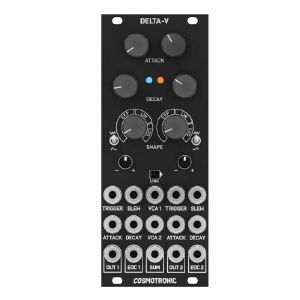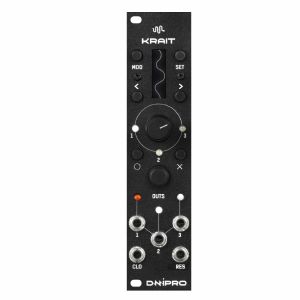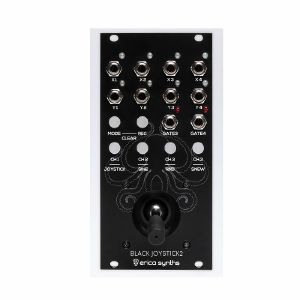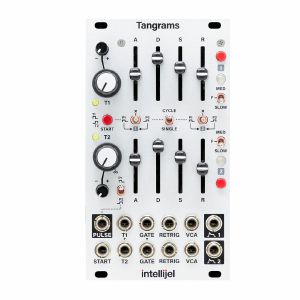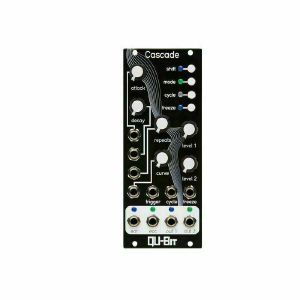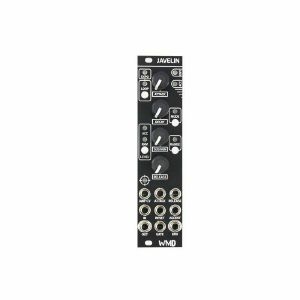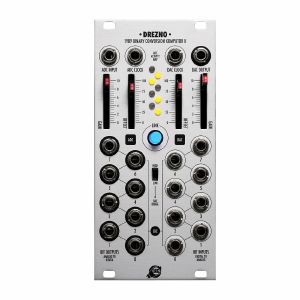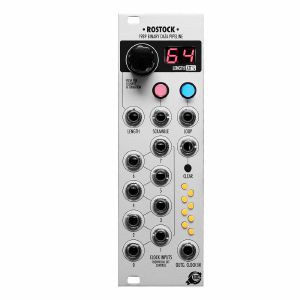Back catalogue: All genres
Juno's full catalogue of All genresBuchla & TipTop Audio Quad Sample & Hold/Polyphonic Adapter Model 264t Module (sample & hold synth module)
Cat: 1069586 Rel: 08 Apr 25
Quad sample & hold, CV modulation module - 18hp
Notes: Part of TipTop's exceptional series of Eurorack-format Buchla modules, the 264t provides four sample-and-hold circuits, plus a logic circuit designed to control polyphonic patches. Deceptively simple but surprisingly creative, like most Buchla modules.
Supplier's Notes:
Four independent sample-and-hold circuits, plus a specialized logic circuit for expediently implementing polyphonic patches.
Sample-and-hold's are essentially one-cell analog memories. They are useful for "remembering" the instantaneous value of a control voltage (a detected envelope, for example), for generating equally spaced steps from a constant slope input (as from a 281t envelope generator), and for converting any continuously changing voltage (a random voltage, for instance) into a series of discrete values.
The 264's sample-and-hold circuits have two operating modes: sample and track. In the sample mode, the value of the input is sampled and applied to the output whenever a pulse is received. The output remains at this value until the next pulse arrives. The track mode di ers in that an input is applied to the output for the duration of the pulse. The output tracks the input until the end of the pulse and remains at a constant value until the next pulse.
To use the 264t as four independent channels set the separate/common switch to separate. A single CV can be set to all four channels by setting the operate/common to common and plug CV in the the back jack on the with right side.
The Model 264t includes a polyphonic adaptor, which performs the logic necessary to implement four-voice polyphony. Facilities are incorporated for fine tuning and f.m. modulating the oscillators; light emitters display the adaptor's operation.
Specifications:
Size: 18 HP - Depth: 45mm
Power: +12V 60mA / -12V 30mA
… Read moreSupplier's Notes:
Four independent sample-and-hold circuits, plus a specialized logic circuit for expediently implementing polyphonic patches.
Sample-and-hold's are essentially one-cell analog memories. They are useful for "remembering" the instantaneous value of a control voltage (a detected envelope, for example), for generating equally spaced steps from a constant slope input (as from a 281t envelope generator), and for converting any continuously changing voltage (a random voltage, for instance) into a series of discrete values.
The 264's sample-and-hold circuits have two operating modes: sample and track. In the sample mode, the value of the input is sampled and applied to the output whenever a pulse is received. The output remains at this value until the next pulse arrives. The track mode di ers in that an input is applied to the output for the duration of the pulse. The output tracks the input until the end of the pulse and remains at a constant value until the next pulse.
To use the 264t as four independent channels set the separate/common switch to separate. A single CV can be set to all four channels by setting the operate/common to common and plug CV in the the back jack on the with right side.
The Model 264t includes a polyphonic adaptor, which performs the logic necessary to implement four-voice polyphony. Facilities are incorporated for fine tuning and f.m. modulating the oscillators; light emitters display the adaptor's operation.
Specifications:
Size: 18 HP - Depth: 45mm
Power: +12V 60mA / -12V 30mA
More than 10 in stock $292.77
Cosmotronic Delta-V Dual Amped Envelope Generator Module (black) (CV modulation/envelope generator/LFO/polarizer/slew limiter/utility/VCA synth module)
Cat: 803494 Rel: 20 May 21
CV modulation/envelope generator/LFO/polariser/slew limiter/utility/VCA module
Notes: Delta-V is a fully analogue dual-channel function generator, featuring a dedicated VCA and LFO cycle switch for each channel. It packs a great deal of functionality in only 10HP, and will surely find use in almost every patch.
Generate envelopes, slew gates and signals, or run LFOs with precise control over attack and decay times. Using the SHAPE knob, Delta-v can create a wide range of envelopes, from very snappy exponential curves for percussion to logarithmic thumps for bass lines.
If VCA's input is unpatched, the module outputs a regular voltage envelope. When an audio signal is patched into the VCA input, the output signal becomes the audio signal amplified by the envelope.
Sending other envelopes or an LFO to VCA input lets you modulate those modulators, quickly creating complex control voltages that go beyond the usual attack-decay envelope.
Combine this with the SUM output, which sums the two channels, and the attenuverters, which can quickly attenuate or invert the signal, and you have a whole array of signal processing capabilities.
The TRIGGER input fires a Attack-Decay envelope, while the SLEW input will affect the rate of change of the signal.
The trigger for channel 1 and 2 can be linked together, so you can fire two envelopes with one patch cable.
Each channel has an End of Cycle output, (EOC) this outputs a short trigger at the end of each envelope cycle.
The output voltage ranges from -10 to +10 volts, set with handy output attenuverters.
The CYCLE switch starts looping the envelope, creating LFO's that go up to audio rate, and that can also be used as an interesting sound source.
There are many ways to utilise Delta-V.
Challenge yourself to explore new, unconventional territories!
Width: 10HP
Depth: 27MM
Power: +12V 70 MA
Power: -12V 70 MA
Power 5V: 0 MA
… Read moreGenerate envelopes, slew gates and signals, or run LFOs with precise control over attack and decay times. Using the SHAPE knob, Delta-v can create a wide range of envelopes, from very snappy exponential curves for percussion to logarithmic thumps for bass lines.
If VCA's input is unpatched, the module outputs a regular voltage envelope. When an audio signal is patched into the VCA input, the output signal becomes the audio signal amplified by the envelope.
Sending other envelopes or an LFO to VCA input lets you modulate those modulators, quickly creating complex control voltages that go beyond the usual attack-decay envelope.
Combine this with the SUM output, which sums the two channels, and the attenuverters, which can quickly attenuate or invert the signal, and you have a whole array of signal processing capabilities.
The TRIGGER input fires a Attack-Decay envelope, while the SLEW input will affect the rate of change of the signal.
The trigger for channel 1 and 2 can be linked together, so you can fire two envelopes with one patch cable.
Each channel has an End of Cycle output, (EOC) this outputs a short trigger at the end of each envelope cycle.
The output voltage ranges from -10 to +10 volts, set with handy output attenuverters.
The CYCLE switch starts looping the envelope, creating LFO's that go up to audio rate, and that can also be used as an interesting sound source.
There are many ways to utilise Delta-V.
Challenge yourself to explore new, unconventional territories!
Width: 10HP
Depth: 27MM
Power: +12V 70 MA
Power: -12V 70 MA
Power 5V: 0 MA
3 in stock $220.42
Click for better price!
or call +44 20 7424 1960
quote 803494
quote 803494
Dnipro Krait 3-Channel Knob Recorder/LFO/Random Generator Module (controller/LFO/random synth module)
Cat: 846610 Rel: 01 Nov 21
A 3-channel knob recorder, LFO & random generator.
Notes: Dnipro serve up a solid option for generating modulation signals: knob recording, LFOs or loopable random modulation, all syncable to a clock signal. Nice touches include tap tempo and slew.
Supplier's Notes:
Krait is flexible 3-channel modulation source for eurorack system. Each channel can be either a Knob Recorder, LFO or loopable Random Generator.
The module is designed to be in solid sync with your beats, so in order to work, Krait should receive steady external clock pulse. However, LFO will work without clock. All settings and waveforms will be autosaved and reloaded after power off.
Knob Recorder:
Can record pot turns, up to 8 bars loops possible.
LFO:
Tap tempo LFO with morphable waveforms and phase offset. Sync it to your beats.
Random Generator:
Syncable random with portamento and possibility to freeze and loop 16 steps.
Technical details:
6 HP
70 mA +12V
12mA -12V
0 mA 5V
42 mm deep
Voltage ranges: +5-5v, 0v+5v
… Read moreSupplier's Notes:
Krait is flexible 3-channel modulation source for eurorack system. Each channel can be either a Knob Recorder, LFO or loopable Random Generator.
The module is designed to be in solid sync with your beats, so in order to work, Krait should receive steady external clock pulse. However, LFO will work without clock. All settings and waveforms will be autosaved and reloaded after power off.
Knob Recorder:
Can record pot turns, up to 8 bars loops possible.
LFO:
Tap tempo LFO with morphable waveforms and phase offset. Sync it to your beats.
Random Generator:
Syncable random with portamento and possibility to freeze and loop 16 steps.
Technical details:
6 HP
70 mA +12V
12mA -12V
0 mA 5V
42 mm deep
Voltage ranges: +5-5v, 0v+5v
1 in stock $279.21
Click for better price!
or call +44 20 7424 1960
quote 846610
quote 846610
Erica Synths Black Joystick2 4-Channel Recordable Joystick Controller Module (controller synth module)
Cat: 812600 Rel: 23 Feb 21
8-channel multi-functional CV source, joystick, movement recorder & distinct LFO module - 12HP
Notes: Multi-function eight-channel LFO, joystick, movement recorder and drone oscillator that packs in lots more functionality than you might expect. A real modulation powerhouse in a compact format.
Supplier's Notes:
Erica Synths Black Joystick2 is 8 channel multi functional CV and sound source - joystick, movement recorder, distinct LFO and drone/noise oscillator. It provides great interaction with the modular system and allows to develop unconventional modulation patterns instantly.
… Read moreSupplier's Notes:
Erica Synths Black Joystick2 is 8 channel multi functional CV and sound source - joystick, movement recorder, distinct LFO and drone/noise oscillator. It provides great interaction with the modular system and allows to develop unconventional modulation patterns instantly.
1 in stock $235.12
Intellijel Tangrams Dual Analogue Core-Envelope Module (clock generator/CV modulation/envelope generator/function generator/LFO/VCA synth module)
Cat: 962200 Rel: 04 Aug 23
Dual ADSR/VCA module with cycling gate pulsers - 14HP.
Notes: Tangrams
Push (or Pulse) the Envelope
Snappy, classically analogue envelopes with visually intuitive controls. Add a powerful, cv controllable cyclical gate generator, integrated VCA, and trigger buttons -then double it-now you've got Tangrams.
Tangrams, like the Dual ADSR before it, is a dual analogue core-envelope inspired by the Roland SH-101 / System 100m design with several enhancements. Taking further inspiration from trapezoidal function generators like the one on the EMS Synthi, Intellijel have added a voltage-controlled pulser circuit to link the triggering of two envelopes - allowing for delayed one-shots, cycling organic envelopes, and more. In addition, Intellijel added two VCAs for level control of each envelope, or alternatively, direct injection of the signal you'd like to envelope - freeing up your other VCAs.
The Pulser
The Pulser can be thought of as a way to set both a gate ON time (T1) and an OFF time (T2). In this way, you could configure a cycling ADSR that has a gate time that is different from the interval between gates. Alternatively, you can create a sequence where ADSR2 is triggered by a delayed amount of time after ADSR1 is triggered (either cyclically or in a single shot sequence). The panel switches for routing or disabling the pulse sources allow for even more complex combinations of control beyond these examples. This special combination of functions can yield a plethora of interesting and organic envelope and gate patterns to be created; cyclical and single shot.
ADSR + VCA Features
Dual Analogue ADSR envelopes with digital gate Pulser for trapezoid shapes
Pulser stages P1 and P2 can be selectively routed to trigger each ADSR via panel switches
Three timing ranges: (FAST: ~5 seconds, MED: ~35sec, SLOW: ~1min A/D times)
Retrig input (allows re-triggering of the envelope if source gate held high)
VCA input can be used to dynamically control the respective ADSR output level (bipolar) or to process signals to be modulated in amplitude by the ADSR.
Manual GATE buttons for each envelope
Pulser Features
A pulse is made of individually controllable T1 and T2 stage lengths
CV control over T1 and T2 time
Pulser can be one-shot (SINGLE) or repeating (CYCLE)
PULSE output has a switch to select P1 or P2 as the source.
Pulser stages P1 and P2 can be selectively routed to trigger each ADSR via panel switches
START trigger input for starting/restarting the Pulser sequence
Manual GATE button to trigger the Pulser sequence
Size: 14HP
Depth: 35mm
Power: 66mA @ +12V 49mA @ -12V
… Read morePush (or Pulse) the Envelope
Snappy, classically analogue envelopes with visually intuitive controls. Add a powerful, cv controllable cyclical gate generator, integrated VCA, and trigger buttons -then double it-now you've got Tangrams.
Tangrams, like the Dual ADSR before it, is a dual analogue core-envelope inspired by the Roland SH-101 / System 100m design with several enhancements. Taking further inspiration from trapezoidal function generators like the one on the EMS Synthi, Intellijel have added a voltage-controlled pulser circuit to link the triggering of two envelopes - allowing for delayed one-shots, cycling organic envelopes, and more. In addition, Intellijel added two VCAs for level control of each envelope, or alternatively, direct injection of the signal you'd like to envelope - freeing up your other VCAs.
The Pulser
The Pulser can be thought of as a way to set both a gate ON time (T1) and an OFF time (T2). In this way, you could configure a cycling ADSR that has a gate time that is different from the interval between gates. Alternatively, you can create a sequence where ADSR2 is triggered by a delayed amount of time after ADSR1 is triggered (either cyclically or in a single shot sequence). The panel switches for routing or disabling the pulse sources allow for even more complex combinations of control beyond these examples. This special combination of functions can yield a plethora of interesting and organic envelope and gate patterns to be created; cyclical and single shot.
ADSR + VCA Features
Dual Analogue ADSR envelopes with digital gate Pulser for trapezoid shapes
Pulser stages P1 and P2 can be selectively routed to trigger each ADSR via panel switches
Three timing ranges: (FAST: ~5 seconds, MED: ~35sec, SLOW: ~1min A/D times)
Retrig input (allows re-triggering of the envelope if source gate held high)
VCA input can be used to dynamically control the respective ADSR output level (bipolar) or to process signals to be modulated in amplitude by the ADSR.
Manual GATE buttons for each envelope
Pulser Features
A pulse is made of individually controllable T1 and T2 stage lengths
CV control over T1 and T2 time
Pulser can be one-shot (SINGLE) or repeating (CYCLE)
PULSE output has a switch to select P1 or P2 as the source.
Pulser stages P1 and P2 can be selectively routed to trigger each ADSR via panel switches
START trigger input for starting/restarting the Pulser sequence
Manual GATE button to trigger the Pulser sequence
Size: 14HP
Depth: 35mm
Power: 66mA @ +12V 49mA @ -12V
6 in stock $257.72
Click for better price!
or call +44 20 7424 1960
quote 962200
quote 962200
Noise Engineering Clep Diaz Complex CV Generator Module (black) (modulation synth module)
Cat: 741822 Rel: 05 Aug 19
Complex CV generator module with step, LFO & random modes - 4HP
Notes: Clep Diaz is a handy and small step CV and LFO generator. In step and random modes, use the encoder to control the number of steps in the sequence; in LFO mode, the encoder controls the amplitude of the wave. Toggle the directionality of the sequence: up, down, or up/down to customize the CVs further. CD also gives CV control over the number of steps in the sequence and an end-of-cycle trigger output. Unipolar and bipolar outputs allow maximal control.
Dimensions
4 HP
26 mm deep
Current Draw
44 mA +12V
10 mA -12V
0 mA 5V
… Read moreDimensions
4 HP
26 mm deep
Current Draw
44 mA +12V
10 mA -12V
0 mA 5V
1 in stock $201.21
Click for better price!
or call +44 20 7424 1960
quote 741822
quote 741822
Noise Engineering Pons Asinorum 4-Channel Voltage-Controlled Linear Envelope Generator & LFO Module (silver) (envelope generator/LFO synth module)
Cat: 711981 Rel: 13 Dec 18
The bridge of asses. Quad CVable envelope/LFO with three envelope shapes.
Notes: Pons Asinorum is a compact four-channel multimode envelope generator and LFO with voltage control. PA has three different envelope shapes, CV over cycle length, and a unique single encoder control scheme that makes adjusting multiple channels mid-performance easy. Channels can be set separately to envelope mode or to cycle in LFO mode, giving PA maximal flexibility in a minimal footprint.
… Read more1 in stock $204.60
Click for better price!
or call +44 20 7424 1960
quote 711981
quote 711981
Qu-Bit Cascade Ratcheting Envelope Generator & VCA Module (envelope generator/VCA synth module)
Cat: 766031 Rel: 15 Mar 21
A ratcheting envelope generator, VCA and sound source all within a compact form factor.
Notes: Envelope generator meets VCA meets sound source, combining to create a powerful sequencing tool, modulation generator, compression-style effect and more. Versatile.
Supplier's Notes:
Cascade is a ratcheting envelope generator, VCA, and sound source all within a compact form factor. The unique interactions of its feature set open up new worlds of rhythmic patching and modulation. Easily create ratcheting sequences, bouncy-ball modulation, and pumping compression, all within a single module.
At its core, Cascade is a powerful envelope generator, which is normaled to a high fidelity 2164 based VCA. You can patch in external audio to the VCA, or take advantage of 4 internal audio algorithms: white noise, 808 kick and hi-hat, and a high frequency sine tone. Cascade will open up your system in ways that make you wonder how you ever lived without it.
Tech Specs:
Width: 10HP
Depth: 28mm
Current Consumption: +12V=131mA, -12V=40mA, +5V=0mA
… Read moreSupplier's Notes:
Cascade is a ratcheting envelope generator, VCA, and sound source all within a compact form factor. The unique interactions of its feature set open up new worlds of rhythmic patching and modulation. Easily create ratcheting sequences, bouncy-ball modulation, and pumping compression, all within a single module.
At its core, Cascade is a powerful envelope generator, which is normaled to a high fidelity 2164 based VCA. You can patch in external audio to the VCA, or take advantage of 4 internal audio algorithms: white noise, 808 kick and hi-hat, and a high frequency sine tone. Cascade will open up your system in ways that make you wonder how you ever lived without it.
Tech Specs:
Width: 10HP
Depth: 28mm
Current Consumption: +12V=131mA, -12V=40mA, +5V=0mA
1 in stock $236.82
Click for better price!
or call +44 20 7424 1960
quote 766031
quote 766031
Tesseract Modular Stonk Joystick Controller & Looper Module (controller/CV modulation/effect/looper synth module)
Cat: 971886 Rel: 17 Nov 23
Joystick controller module with 2 channels of CV and 2 channels of audio - 12HP.
Notes: Stonk it's a joystick controller with 2 channels of CV and 2 of audio. It's a CV generator, looper & audio processor.
Very hands on module which can be a chaos pad or DJ looper.
Features:
2 audio in & out (AC coupled)
2 CV in & out (DC coupled) i5V
2 extra CV outputs +/-10V
12 illuminated push buttons
CV & Audio looper (2:30 per channel)
LFO
Euclidean envelope generator
Multimode Filter
Stereo Reverb
Wave
VCA
The audio AD/DA is 24 bit, 48 KHz, the internal audio handle is 32 bit float.
The CV AD/DA is 16/12 bits, 12 KHz.
The extra CV outputs are the analogue sum and difference of the CV outputs 1 & 2.
Each channel has 6 modes available. By default 2 parameters are assigned to the horizontal & vertical axes but this can be easily tweaked, so it's possible to control any of them (frequency, symmetry, offset or amplitude of the LFO, for example) not only with the joystick but with the 2 CV inputs.
The polarity control & offset of every parameter can also be modified on every mode and every channel.
6 presets for store and recall not only the joystick assignment and settings but all the parameter values for all modes and channels.
Size 12 HP
mA +12V
mA -12V
… Read moreVery hands on module which can be a chaos pad or DJ looper.
Features:
2 audio in & out (AC coupled)
2 CV in & out (DC coupled) i5V
2 extra CV outputs +/-10V
12 illuminated push buttons
CV & Audio looper (2:30 per channel)
LFO
Euclidean envelope generator
Multimode Filter
Stereo Reverb
Wave
VCA
The audio AD/DA is 24 bit, 48 KHz, the internal audio handle is 32 bit float.
The CV AD/DA is 16/12 bits, 12 KHz.
The extra CV outputs are the analogue sum and difference of the CV outputs 1 & 2.
Each channel has 6 modes available. By default 2 parameters are assigned to the horizontal & vertical axes but this can be easily tweaked, so it's possible to control any of them (frequency, symmetry, offset or amplitude of the LFO, for example) not only with the joystick but with the 2 CV inputs.
The polarity control & offset of every parameter can also be modified on every mode and every channel.
6 presets for store and recall not only the joystick assignment and settings but all the parameter values for all modes and channels.
Size 12 HP
mA +12V
mA -12V
1 in stock $289.38
Click for better price!
or call +44 20 7424 1960
quote 971886
quote 971886
WMD Javelin Expressive Envelope & Amplitude Controller Module (CV modulation/envelope generator/LFO/VCA synth module)
Cat: 784089 Rel: 15 Jul 20
ADSR envelope module with integrated VCA - 6HP.
Notes: Javelin is a module that is basically an ADSR envelope with integrated VCA. However, it has several features that make the module an expressive sound shaping tool.
Three level ranges determine the total amplitude of the envelope, additionally three different time ranges are integrated, which can be switched between.
The accent behaviour is also unique. If several gates are applied to the Accent input at the same time, the envelope rises slightly with each gate.
Features:
Attack-decay-sustain-release envelope
Integrated VCA
Unique accent behaviour for expressive sequences
Reset input
CV control over attack and release
Looping mode for LFO-like modulations
Mode switch for gate and trigger behaviour
Linear, moderate or steep exponential shape
Short hold in the peak of the attack for more punch
Power consumption: 93mA at +12V and 65mA at -12V
Depth: 38mm
HP : 6
… Read moreThree level ranges determine the total amplitude of the envelope, additionally three different time ranges are integrated, which can be switched between.
The accent behaviour is also unique. If several gates are applied to the Accent input at the same time, the envelope rises slightly with each gate.
Features:
Attack-decay-sustain-release envelope
Integrated VCA
Unique accent behaviour for expressive sequences
Reset input
CV control over attack and release
Looping mode for LFO-like modulations
Mode switch for gate and trigger behaviour
Linear, moderate or steep exponential shape
Short hold in the peak of the attack for more punch
Power consumption: 93mA at +12V and 65mA at -12V
Depth: 38mm
HP : 6
1 in stock $270.16
Click for better price!
or call +44 20 7424 1960
quote 784089
quote 784089
Xaoc Devices Drezno II 1989 Binary Conversion Komputor Module (comparator/CV modulation/distortion/frequency divider/logic/quantizer/sample & hold/waveshaper synth module)
Cat: 945630 Rel: 10 Nov 23
An improved version of the original Drezno module in 12HP.
Notes: Part of Xaoc's Leibniz Binary Subsystem, the updated Drezno ADC/DAC module builds on the original with higher resolution converters, allowing you to use it for pitch quantisation.
Supplier's Notes:
Drezno II is an improved version of the original Drezno module. It is an essential member of the 8-bit Xaoc Devices Leibniz Binary Subsystem. The Leibniz subsystem is a family of modules that operate on 8 binary (two-state, on/off) signals. These signals are arranged as 8 bits of digital data and may represent analogue signals and voltages, or they may be whatever you want them to be (clocks, gates, rhythms, etc.).
Drezno features an ADC (analogue-to-digital-converter) and DAC (digital-to-analogue-converter), allowing it to act as an analog front-end of the system. In other words, Drezno allows one to convert analogue signals and CVs into digital numbers, as well as to obtain analogue signals back from some other digital numbers (or 8 binary signals). Between these two conversions there is a whole universe of digital shenanigans waiting to happen resulting in all kinds of signal transformations and modulations.
Both (ADC and DAC) sections of Drezno can work independently, or they can be linked. Input and output range of analogue signals may be adjusted using Gain and Offset sliders. Individual bit outputs (for the ADC) and inputs (DAC) allow for extensive cross-patching and the creation of complex waveforms and rhythms. A very fast clock (up to 2MHz) at which the conversions are performed may be replaced with any external clock (for each section separately).
Compared to its predecessor, Drezno II uses new converters of much higher resolution which results in much lower noise floor and higher accuracy. The lower bits are much more stable than before. It is easy now to use Drezno for quantizing pitch voltages with accurate results with 128 or 256 semitone steps. Potentiometer ranges are factory calibrated for precise chromatic scale. A new switch on the front panel allows the user to select the calibrated range of 10Vpp or 20Vpp, so that the lowest bit or the second bit correspond to 1 semitone.
Technical details
Eurorack synth compatible
12hp, skiff friendly
Current draw: +80mA/-50mA
Reverse power protection
… Read moreSupplier's Notes:
Drezno II is an improved version of the original Drezno module. It is an essential member of the 8-bit Xaoc Devices Leibniz Binary Subsystem. The Leibniz subsystem is a family of modules that operate on 8 binary (two-state, on/off) signals. These signals are arranged as 8 bits of digital data and may represent analogue signals and voltages, or they may be whatever you want them to be (clocks, gates, rhythms, etc.).
Drezno features an ADC (analogue-to-digital-converter) and DAC (digital-to-analogue-converter), allowing it to act as an analog front-end of the system. In other words, Drezno allows one to convert analogue signals and CVs into digital numbers, as well as to obtain analogue signals back from some other digital numbers (or 8 binary signals). Between these two conversions there is a whole universe of digital shenanigans waiting to happen resulting in all kinds of signal transformations and modulations.
Both (ADC and DAC) sections of Drezno can work independently, or they can be linked. Input and output range of analogue signals may be adjusted using Gain and Offset sliders. Individual bit outputs (for the ADC) and inputs (DAC) allow for extensive cross-patching and the creation of complex waveforms and rhythms. A very fast clock (up to 2MHz) at which the conversions are performed may be replaced with any external clock (for each section separately).
Compared to its predecessor, Drezno II uses new converters of much higher resolution which results in much lower noise floor and higher accuracy. The lower bits are much more stable than before. It is easy now to use Drezno for quantizing pitch voltages with accurate results with 128 or 256 semitone steps. Potentiometer ranges are factory calibrated for precise chromatic scale. A new switch on the front panel allows the user to select the calibrated range of 10Vpp or 20Vpp, so that the lowest bit or the second bit correspond to 1 semitone.
Technical details
Eurorack synth compatible
12hp, skiff friendly
Current draw: +80mA/-50mA
Reverse power protection
1 in stock $267.90
Xaoc Devices Rostock 1989 Binary Data Pipeline Module (CV modulation/digital/looper/delay synth module)
Cat: 945640 Rel: 15 Jun 23
A data pipeline, a FIFO (first in, first out) shift register or a digital delay module in 8HP.
Notes: Part of Xaoc's Leibniz binary system, the Rostock is a digital delay line capable of processing triggers, audio, CV and video signals. Another useful module from the unique Leibniz series.
Supplier's Notes:
Rostock is a component of the Leibniz Binary Subsystem. It is a data pipeline, a FIFO (first in - first out) shift register, or a very short digital delay. The module operates similarly to a BBD delay or an ASR (analogue shift register), except that it is digital. It consists of a chain of memory cells that pass bits from one to another at each clock cycle. The delay length is variable from 1 to 64 stages (with optional looping and scrambling). It works by processing data in the Leibniz bus and must be connected to other Leibniz modules using data ribbon cables at the back. Rostock may process data sequences representing rhythms, control voltages, audio-rate signals, and even video signals because the bits can change at extreme rates (up to 2MHz). In addition, its memory may be digitally looped. Delaying and looping is a fundamental building block for sequence automation, pattern and chaos generation, and various cybernetic modular patches. Thus, Rostock is a multi-purpose open-ended device that invites creative thinking.
Technical details
Eurorack synth compatible
8hp, skiff friendly
Current draw: +70mA/-40mA
Reverse power protection
… Read moreSupplier's Notes:
Rostock is a component of the Leibniz Binary Subsystem. It is a data pipeline, a FIFO (first in - first out) shift register, or a very short digital delay. The module operates similarly to a BBD delay or an ASR (analogue shift register), except that it is digital. It consists of a chain of memory cells that pass bits from one to another at each clock cycle. The delay length is variable from 1 to 64 stages (with optional looping and scrambling). It works by processing data in the Leibniz bus and must be connected to other Leibniz modules using data ribbon cables at the back. Rostock may process data sequences representing rhythms, control voltages, audio-rate signals, and even video signals because the bits can change at extreme rates (up to 2MHz). In addition, its memory may be digitally looped. Delaying and looping is a fundamental building block for sequence automation, pattern and chaos generation, and various cybernetic modular patches. Thus, Rostock is a multi-purpose open-ended device that invites creative thinking.
Technical details
Eurorack synth compatible
8hp, skiff friendly
Current draw: +70mA/-40mA
Reverse power protection
1 in stock $248.69

 USD
USD







